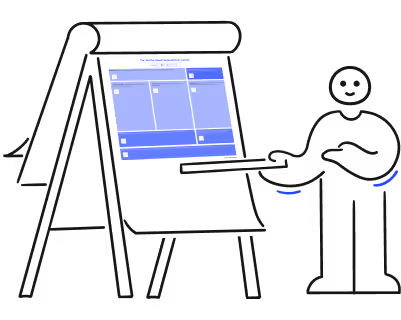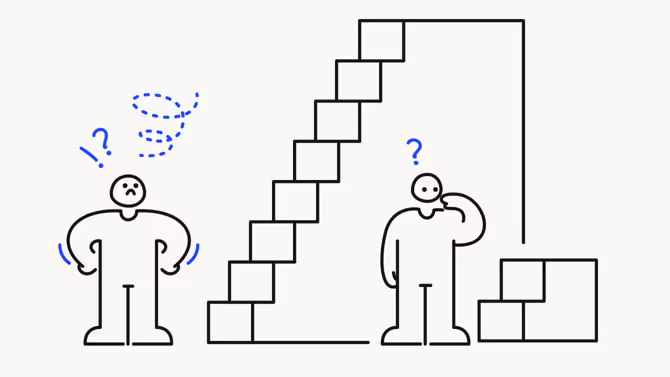Skills gap analysis in 4 easy steps

Empower your organization with the skills-based canvas.

Your company is struggling to meet its objectives?
Is a corporate restructure planned for the months to come?
Are you considering a product or market pivot to accelerate growth?
In all of these situations, amongst others, it is important to run a skills gap analysis.
A skills gap is the difference between the skills needed in the organization (employer needs) and the current skills of the workforce (employee capabilities). Identifying a skills gap allows a manager to target training or direct future hires to supplement the skills of the team.
Performing a skills gap analysis helps you identify the skills the company needs to meet its business goals in both the short and long terms.
This best practice has several benefits for your business since it:
- Encourages proactivity as a vector of growth
- Allows you to use your training budget more strategically
- Highlights weaknesses in your current training process
- Establishes the guideline for your future hiring and recruiting needs
How can the skills gap analysis help me and my business?
Here are some contextual insights to better understand the potential impact a skills gap analysis can have on your organization.
Let’s use a classic situation where the sales team fails to meet goals regularly.
A department-focused skills gap analysis can help you understand that your sales team's negotiation skill is a weakness. By knowing the cause of your current problem, you can make better decisions about how to adjust the shot.
Now suppose that another department in your company has an unusually high turnover rate.
An analysis can show that the current manager lacks empathy according to your standards and causes the resignation of various employees. You should therefore seek to better support the interpersonal skills of your managers or revising their specific position in the organization.
Finally, what if your business regularly receives negative testimonials and reviews on the web?
An analysis might tell you that the after-sales team is not using your CRM properly because they are uneasy with new technologies. The follow-ups with your new customers are therefore often neglected and they feel a palpable frustration. This is an opportunity to review internal procedures and organize training sessions for this team.
These are just a few examples that illustrate the importance and usefulness of a skills gap analysis.
How to do a skills gap analysis?
While there are different ways to do an analysis, here is a simple and effective 4-step approach.
It can allow you to have quick and measurable results and thus take the necessary actions.
Step 1: List your organization’s skill needs
First, you need to have a good understanding of the skills that are necessary within your organization to achieve its business goals.
You must therefore make a list of the different skills that the company needs to meet its ambitions. This includes both operational skills (process execution) and interpersonal skills (employee management).
First, it is good to establish what the "universal" skills are in your organization. Those should be found in each and any employees and are judged as the basic standards required to be hired.
You should then sort out the skills specific to each department since the needs may vary. Be as specific as possible, so that words are easy to contextualize.
For example, the expectation for managers’ empathy towards their employees is not the same as an employee's empathy for a customer.
The importance and degree of intensity in internal and external contexts can vary expectations and behaviour.
This approach will allow you to avoid a common problem related to "skill expectations".
In the context of labour scarcity, it is difficult and unrealistic for an employer to expect new employees to be experts on day 1. It is, therefore, necessary to be able to identify the minimum level of skill mastery for each department.
Do your employees have to be “beginner”, “intermediate” or “advanced” to meet your standards? It is up to you to determine what is required to support your goals.
It is important to ensure that the list contains the skills deemed necessary now and in the near future. Therefore, you must consider the skills required for future projects to be proactive and always ready for your next opportunity.
Keep in mind that you do not have control over the learning speed of each of your employees. Acknowledging learning curves and strategically planning things accordingly can be a major difference-maker for growth-oriented businesses.
For this reason, it is wiser to be proactive with skills development.
The final skills list will then become your reference guide to assess the situation.
Step 2: Measure the actual skills of the team
Before measuring employee skills, it is important to communicate the intent behind your skills gap analysis. This will prevent it from being seen as a formal evaluation by employees, which could cause mistrust.
A skills gap analysis is a positive business practice.
Without warning employees, this exercise could be viewed negatively, have people on the defensive and damage the business culture.
Since you need everyone's cooperation to conduct a reliable analysis, it pays to be transparent. Openly communicate the elements or concerns that led you to perform this analysis.
It must be clarified that this is a collaborative and constructive practice to seek possible solutions.
Skill measurement can be done in different ways, depending on what you want to accomplish.
You could, among other things:
- Run a team survey
- Perform individual interviews and assessments
- Analyze the last 3 evaluations of each employee
- Use specialized apps
- Etc.
The end goal is to be able to put a score per skill, per employee, and then come up with a team average.
A score assigned on a scale of 5 or 10 is often used to have a better level of precision on the deviation. It also allows you to determine the training urgency required to address the root of your current problems.
Each increment of the scale should be supported by pre-defined expectations, actions, responsibilities and expectations. This will ensure that employee ratings are done fairly and consistently throughout the review.
“If you can do X but not Y or Z, you are a 3. If you can do X and Y but not Z, you are a 4” and so on.
Step 3: Analyze the skills gap
At this point, you have in hand the list of desired organizational skills and the list of actual skills from your employees.
Now you can compare the data to identify risk areas and organizational issues that arise from low skills or disparities.
Knowing your risk areas is good news! It gives you a head start and more control to steer the ship back on its course and develop the skills of your employees accordingly.
Set up a game plan based on priority issues and available resources.
This also represents an opportunity to review or optimize individual employee’s development plans.
Take the time to think about what could have caused this discrepancy in the first place.
To establish the action plan, here are some key questions to ask yourself:
- Are there big gaps between our expectations and reality?
- Are there big skills gaps between employees in the same department?
- Are the differences associated with one-off needs, or with recurring needs?
- Do employees have time dedicated to continuing education?
- Do employees have access to training content for their role?
Your findings from these questions will set the stage for the next step.
Step 4: Take action, by priority
If step #3 gave you an understanding of the weaknesses and sources of your skills issues, now is the time to take action!
However, you cannot do everything all at once.
As you have a limited budget and resources, it is important to take action on what is considered a priority.
Priority can be determined according to different criteria, such as:
- The volume of people affected
- Direct or indirect damages caused by the skills gap
- The strategic alignment of a missing skill to support current and upcoming growth objectives
- Etc.
In any case, you should take measures that support improving the company’s skills and those of the individual regularly.
To do this, you need tools and processes that help close the gap. These elements are the conditions for success to reduce the risk of seeing this problem recur in the future.
It is good practice to set up an individual development plan.
On the one hand, it directly involves and engages the employees in the development of their skills according to current expectations. On the other hand, it also supports their ambitions for advancement within the company.
The implementation of a training platform lis an ideal project to carry out this development plan.
Easily accessible will allow you to better document and distribute training content to measure progress towards improving critical business skills.
Do you have skilled employees who would like to share their knowledge? Involve them as content creators and trainers!
Creating a mentoring committee can also be a good solution to standardize the collective expertise of your departments.
If your employees participate in external training, map out a process so that they can document and debrief the rest of the department on all of the new things they have learned.
This allows you to increase the return on investment of each training for which an employee is allocated a budget. He then has the responsibility of making a presentation of his learning and acquired knowledge to expose his colleagues to best practices.
Recruiting a new resource is a strategic decision that can make up for missing skills.
Although it costs a bit more upfront, hiring a skilled expert is a business power move that speeds up results and can raise the skill level of the entire team in no time. This will generate compound interest to make up for the upfront cost of this expert resource.
As you can see, taking action becomes easy when you have a good understanding of the real problem and your goal.
Follow up on the evolution of skills development
Obviously, the work doesn't end there.
A skills gap analysis is a picture frozen in time. It is our responsibility to make it a common practice to see if the actions taken are generating results.
We especially want to assess whether the gains we make are sustainable in the long term.
Developing a skill takes time. Employees must therefore be allowed to learn, practice, fail and develop new reflexes.
An annual review may be enough to stay proactive and monitor the progress of your business and the people within.
%20(1).png)

%20(1).avif)


.avif)
.avif)








